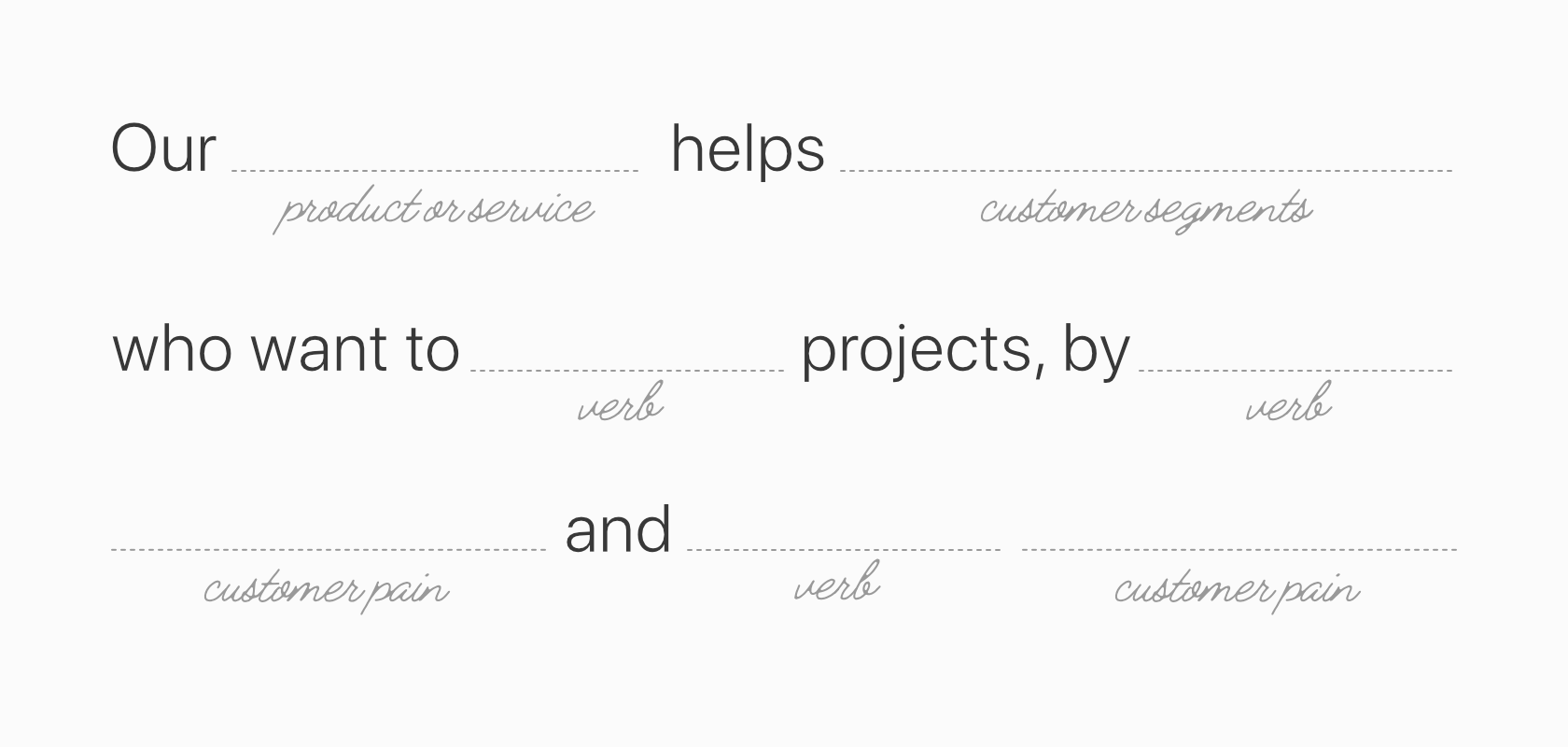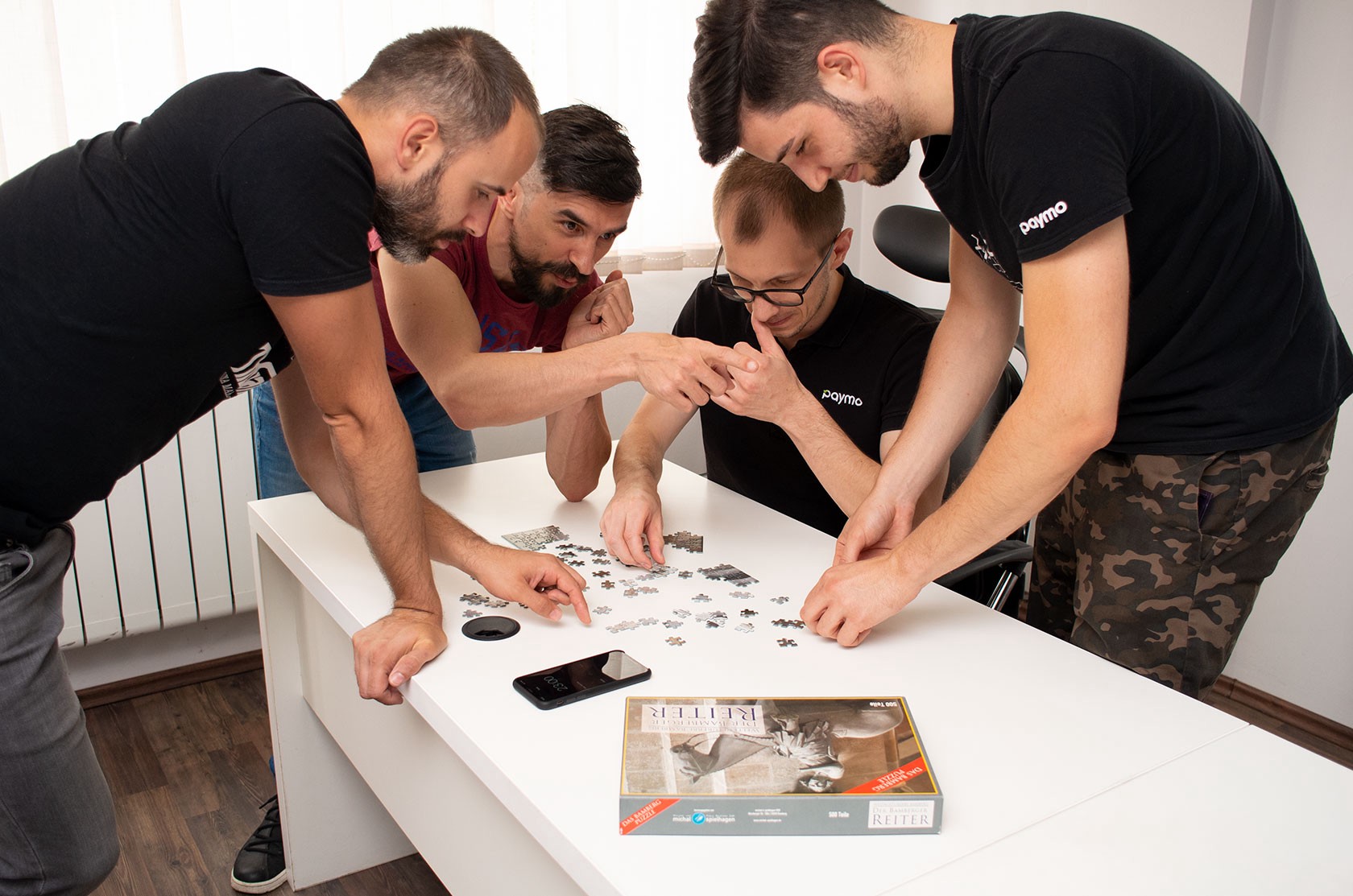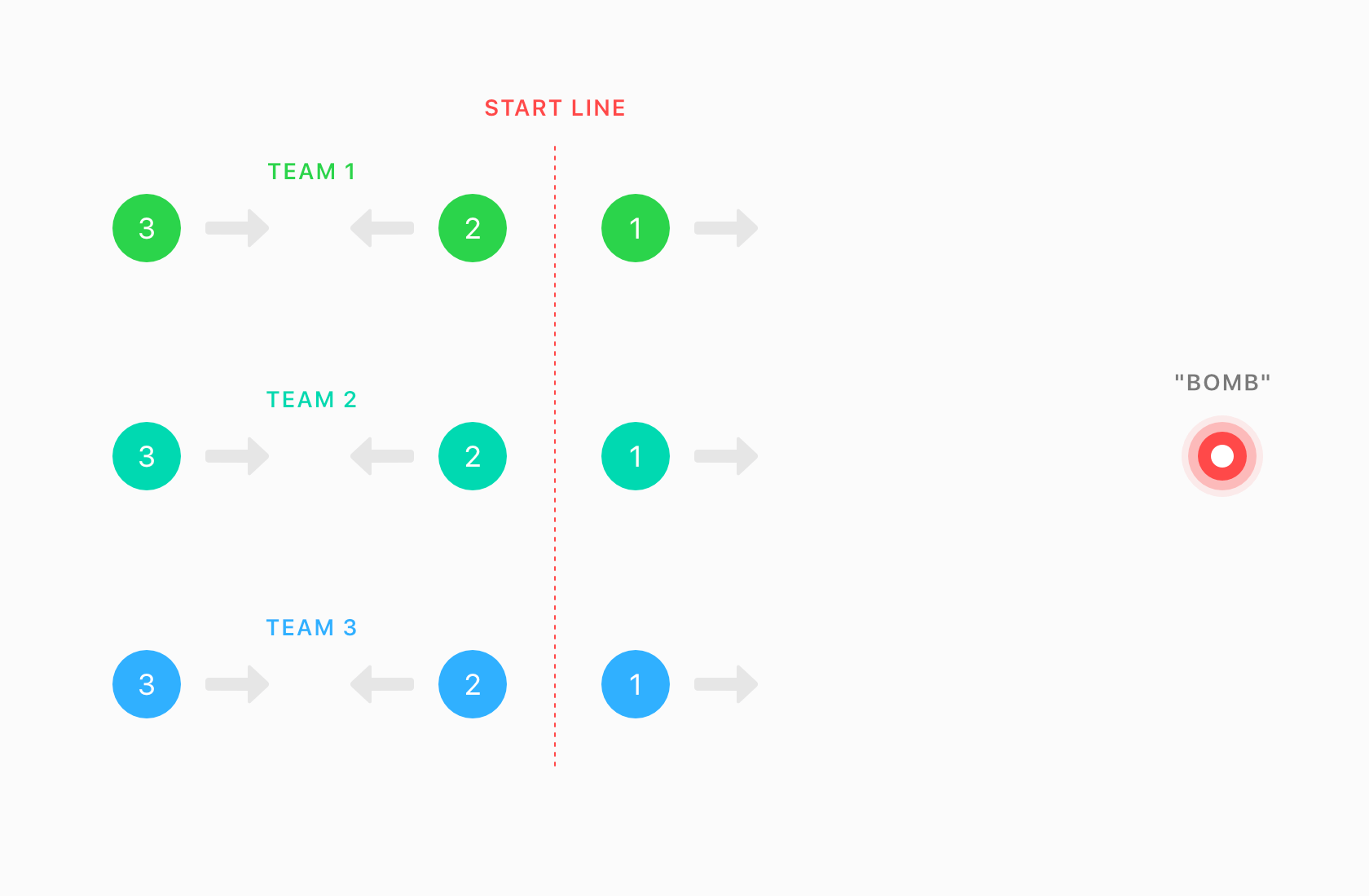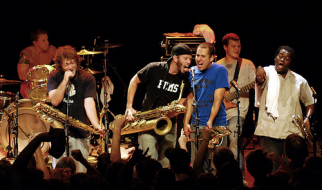Teams that bond together, succeed together. Easier said than done.
That?s because in reality, team-building activities are hard to swallow. Some of your colleagues might not feel comfortable getting too childish, while others might already think about the work they could get done during this time.
Here?s the good news: it doesn?t have to be like this.
If you happen to hold these assumptions as well, remember that:
- Team building activities are not a one-time silly event, but part of an ongoing process. Its aim? To build trust between the members of a team and make sure that everybody is heading in the same direction and following a shared set of values.
- Success doesn?t depend on the number of hours spent at the office but on the quality of your work. In turn, this stems from your well-being. Dealing with a high workload can cause fatigue and burnout in the long run. Resting has its advantages as it helps you see problems from a different, more creative perspective.
Technology giants and start-ups, in particular, have already adopted this mindset, providing office perks and socializing events in the form of free lunches, ping-pong tables, hackathons, and regular parties. They realized early on that productivity is linked with a stress-free work environment, one where everybody works happy and gives their best, while also taking time to blow some steam off. After all, adults are grown-up children that need to play in order to engage their creative side of the brain.
Still not convinced? Have a look below at the positive effects of team building activities.
- Increased trust ? This is the magical ingredient of every high-performing team. People who trust their colleagues, both in character and capability, are more willing to step out of their comfort zone and pursue a common goal. They have each other?s back, which means they don?t need to worry about someone constantly checking their work. Instead, they rely on each of their co-workers? strengths and build something bigger together than they would have done it alone. In the end, nobody wants to work with semi-strangers whom they?re afraid of. Gary Vee sums it up better when he says that ?people work way much better when you deploy honey instead of vinegar?.
- Constructive criticism ? Refers to the courage of speaking up your mind without fearing the consequences. This means that you can share information freely even when you?re wrong and pick up someone?s brains effortlessly. Sure, mistakes can and will happen, but it?s better to rely on a supportive team that points you in the right direction instead of one who will keep the score.
- A leaner and faster onboarding ? We?re talking about the process of helping new hires adapt to the company culture. The sooner you help them to better understand company roles, procedures, and meet their co-workers in person, the faster they will become ready to work and contribute in meaningful ways. Get this part right and you have higher chances of retaining valuable talent for longer periods of time.
If you still feel clumsy about team building activities, don?t worry. We?ve compiled a list of them for you to serve as a go-to resource whenever you feel like it?s time to strengthen your team. It contains 20 games divided into five categories, depending on the goal you want to achieve:
- Icebreakers
- Strategic
- Problem Solving
- Teamwork
- Creative Games
Icebreakers
Often times we work like cars: we need to be warmed up to properly function. If this is your goal, then use icebreakers to loosen up the atmosphere, set the stage for more complex activities, or introduce new hires to the team.
Campfire/Memory Wall
You?ll need: a whiteboard, sticky notes, markersTime: 30?45 minutesGroup size: 8?20
Instructions: Jot down between 5?10 work-related words on sticky notes like ?First day at work?, ?Teamwork?, ?Side projects?, or ?Celebrations?. Place the sticky notes on one side of the whiteboard so they?re visible to the whole team. Next, gather your colleagues in a circle and ask a volunteer to peel off a word to share an experience about it. Once done, they can post it on the other side of the whiteboard to mark the beginning of a story thread. The others can think of similar stories and come up with their own words. They can stick them on the whiteboard to continue the story thread, or pick a word that already exists if nothing pops up in their minds. The goal is to create a set of interconnected stories that act as the campfire?s archive.

Office Trivia
You?ll need: 20?25 index cardsTime: 30 minutesGroup size: Unlimited
Instructions: Who knows most about your office? Find out through a trivia. Think of 20?25 questions about the small details of your workplace that can go easily unnoticed. ?Which movie is featured on the conference room?s poster??, ?What color does the coffee machine have??, ?How many people with the name ?Andrew? work in the company??, ?How many people are using Windows PCs??, etc. This will test your team?s observation skills and spark off serious laughing sessions. Remember not to ask questions that are too personal and would put a team member into an embarrassing situation, like ?Who has the biggest mouth in the office??.
Trading Cards
You?ll need: index cards, markersTime: 10?15 minutesGroup size: Unlimited
Instructions: Remember baseball or Pokemon trading cards? This time, you?re the one who?s being ?traded?. Give out large-scale index cards and markers to each team member. Ask them to create a personal trading card of themselves, with their name, self-portrait, nickname, and one fact about them that everyone is less likely to know about. Then have the cards go from one person to another in no particular order. Participants can hold onto a card if they find the card?s fact interesting and want to know more about it from its owner. The exercise is great because it gives everyone a visual snapshot of each player while triggering conversations on the go.
Penny for Thoughts
You?ll need: pennies or any coins with listed years, box or bucketTime: 10?15 minutesGroup size: Unlimited
Instructions: It might be difficult to start working on a project without properly knowing your colleagues. To loosen up the atmosphere in a short time, gather coins with listed years on them so that you have one for each member. Then drop them in a box or bucket. Remember to check every coin so that the dates are not older than the youngest team member. Finally, have each team member draw a coin and share a memorable moment from their lives that happened in the year when the coin was minted. This brings a sense of familiarity among them and smoothens out future conversations.
Strategic activities
They might look like icebreakers at a first glance, but don?t be fooled. Their aim is to foster a shared team identity by looking into how your employees perceive the company and what influences their opinions.
All the News
You?ll need: newspapers, a whiteboard, tape, scissors, markersTime: 60 minutesGroup size: 6?20
Instructions: Have you always wanted to get a quick peek into your employees? minds to see how they perceive the company? Now?s your chance. Divide people into teams of 3 or 6, preferably by department. Give each team a newspaper and ask them to come up with headlines about what they think the company or the department will achieve in the upcoming future. There are no rules in particular. They can either take newspaper clippings and paste them or write the headlines directly on the whiteboard. When the time?s up, teams pin up their work and discuss each idea to see if they?re feasible or not. The exercise is great for spotting hidden opportunities or threats. It also instills a sense of loyalty as each team member feels they?re appreciated and have a stake to play in the company?s development.
Mad Lib Mission Statement
You?ll need: paper, pensTime: 45 minutesGroup size: 6?20
Instructions: It?s hard to build a brand if the world doesn?t know what you stand for. That?s why you have the mission statement for: to convince other people about what your product or service can (and can?t) do and why you matter. Like in the previous activity, divide your team into groups of 3 to 6, then grab a copy of your mission statement for each team so they can replicate it. The team that comes up with the most authentic mission statement wins. It?s also perhaps an opportunity to change your old one or make everyone aware of the values that your company embodies.

Company Concentration
You?ll need: index cardsTime: 45?60 minutesGroup size: Unlimited
Instructions: Much like the ?Concentration? game from childhood, where you flipped over two cards at the same time to find the matching pairs, this activity demands agility and observation spirit. Create a deck of cards with photos or words about your company. These might be photos of your team, logos, products, or value statements. Face all the cards down, then split the group into teams. Each team has to take turns and lift only two cards at a time to see if they match. The one that finds all the pairs in the shortest time wins. The activity is ideal for new hires who need a fun, yet quick way to learn more about the company. But it isn?t limited only to them. Old hires can brush up their knowledge and stay up to date with the latest organizational changes too.
Group Timeline
You?ll need: a pinboard, pins, paper, pensTime: 60 minutesGroup size: 5?8
Instructions: On the pinboard, draw a blank timeline. Make sure to date it back to the year when your oldest employee was born or when the company was founded. Add years to it, then write down on paper slips the most important company dates (like when it was founded, merged, etc.). Pin them to the corresponding year. Next, ask your team members to think about 3 or 4 events that marked their lives (like graduating college, moving abroad, having a child, etc.) and pin them on the timeline when they occured. The activity brings into perspective the gap between generations. It?s a great starting point for debates that concern the way you collaborate as a team.
Problem solving activities
Getting your team to work together in a productive manner is not a walk in the park. To help them get out of their comfort zones and strive for a common goal, decide for problem-solving activities. Some of them require little logistics and time. Others are more elaborate and involve prolonged states of focus.
Web of Wools
You?ll need: yarnsTime: 30 minGroup size: 9?12
Instructions: Break the group into teams of equal numbers. Then have each team form a web of wools, the more intricate the better. Here comes the best part: switch the teams so everyone has a different web than their own. Each team should then blindfold a team member and have them untangle the web following only their verbal instructions. The first team to do it wins. Sounds easy, right? In reality, it?s not. You have to give concise advice and be receptive enough to follow your colleagues and instincts ? should you be the blindfolded one.
Bridge Build
You?ll need: building materials (like legos, toy bricks, straws, marshmallows, etc.), tape, paper, pens, sheetsTime: 50 minutesGroup size: 8?16
Instructions: Before entering into meetings that require serious brain power, warm up with this game. Split the group into two teams. Then explain how they each have to build half of a bridge with the materials provided. At the end, the bridges should be similar in design and connect. The trick is they can?t see each other, so they?ll have to rely on verbal communication. Remember to set the room up first and place the sheets to divide them. Also, provide the same number of items to each team. In terms of timing, give them 10 minutes to come up with a design, and 30 minutes for building.
The Barter Puzzle
You?ll need: puzzlesTime: 60?90 minutesGroup size: 12?20
Instructions: Not sure how your co-workers reach an agreement when they?re under pressure? Let them negotiate to find out. Divide them into teams of 4 or 5. Then, give each team a different jigsaw puzzle equal in complexity. Explain to them that the puzzles are scrambled, containing parts from the other ones. The goal is to be the first ones to complete their puzzle while engaging in negotiation activities like bartering, exchanging team members, assigning leader roles, etc. Remember that these actions need to be taken by the whole team, not individually. To make things more interesting, you can hand each team a few trading chips with no value assigned to them. Although time-consuming, this activity brings up the best negotiators in each person and gives you a sneak peek into how they strategize decisions.
 The Paymo team playing the Barter Puzzle
The Paymo team playing the Barter Puzzle
Gutter Ball
You?ll need: half pipes, marblesTime: 45?60 minutesGroup size: 8?15
Instructions: The goal of this exercise is to cross marbles of different sizes from one side of the room to the other, without touching the floor. How? Through short lengths of half pipes. Each team member gets one and has to balance it so that it passes down seamlessly. Here?s the trick. The facilitator, you in this case, can add obstacles between the start and end points to make the activity more challenging. You can even come up with extra rules which require team members to take turns or both feet need to remain on the floor, for example. Break the group into teams, let them come up with a plan, then time how long it took for the marbles to pass down. The team that keeps the marble going for the longest time wins. A small word of advice: try to make the race hard, but not impossible, so that each team member is aware of what they can achieve together.
Teamwork activities
Communication, balance, and trust ? these are the traits of healthy teamwork. The following games will test you and make you realize that a team?s value is greater than the sum of all its team members.
Robots
You?ll need: a rope to mark the start line, blindfolds, a ?bomb? in the form of a ballTime: 30 minutesGroup size: 6?12
Instructions: This is a great way to see how your team works together in an uncontrolled environment. The objective? To communicate in such a way as to retrieve a fake ?bomb? before the other teams. Each team contains 3 to 5 members. There are three key roles to remember:
- Robot (1) ? stands blindfolded in front of the start line, facing the bomb and is the only one allowed to move.
- Communicator (2)? stands behind the line and doesn?t face the activity area, nor the robot.
- Observer (3) ? stands in front of the communicator facing the activity area, but is not allowed to talk.

The game begins with the observer who can use any other communication channel to signal the direction to the communicator. The communicator in return has to interpret those signals and give instructions to the robot to retrieve the bomb. As a facilitator, your goal is to observe how each one is communicating both in a verbal and nonverbal way. Pay special attention to the robots when it comes to active listening. The game is great for people who want to better understand the Scrum mechanics. Robots might represent the Scrum team who carries out the sprints. The communicator is the Scrum Master who acts as a servant-leader for the Scrum team. Meanwhile, the observer resembles the Product Owner who prioritizes product specifications and coordinates the Scrum team.


